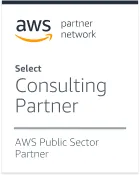
Infrastructure & cloud services
Cloud services are designed to provide easy, scalable and flexible access to applications, computing resources, and services.
let's talk
cloud services
Transformational by design
We do more than set up the pieces required to run your systems. Our AWS Certified architects analyze your business workflows, security profiles and integration points. We establish project planning, version control, automated deployment mechanisms, approval processes, and all of the other DevOps underpinnings that support a modern software ecosystem.
Our products are designed with a global reach in mind. Whatever the anticipated usage of the initial launch, our cloud-first strategy is the same: to deploy a robust infrastructure that is suitable for mission-critical operations.
our capabilities
Cloud services and architecture
There are a lot of moving parts in a production-ready software platform. A typical custom software product has between 10 and 30 distinct moving parts, replicated across several independent environments.
With today's diverse array of cloud solutions, businesses have a lot of decisions to make. Our Cloud Architecture team provides comprehensive guidance for implementing the strategies of cloud adoption and optimization.
Understanding a system's potential attack vectors requires a deep understanding of software infrastructure topology. Our adherence to enterprise best practices and experience in regulated and public sector industries allows us to see the bigger picture.
Scalability is the foundation of cloud computing. A well-designed cloud infrastructure based on microservice architecture can scale up or down to meet any demand in real time. Scaling, monitoring and performance benchmarking are all automated.
We introduce digital innovation to our clients' existing businesses by designing and implementing software ecosystems that allow them to stay competitive and proactively respond to customers' evolving needs. We migrate legacy infrastructure, big or small.
Convergence adheres to the principles of Agile project management. Think of this as a way of working that focuses on iterative planning and delivery with the client at the center. Release early, release often, and embrace roadmap uncertainty.
Cloud cost optimization is the process of reducing overall cloud spending by identifying mismanaged resources, eliminating waste, freeing up capacity, and optimizing the cloud scaling parameters. Costs only grow if your business grows.
Industry partners
Official AWS Partner
Behind all business-grade platforms is a robust cloud-based infrastructure. Convergence is both an AWS Select Consulting Partnerand anAWS Public Sector Partner - we have deep knowledge in the architecture, development and management of the systems that your software ecosystem requires in order to scale.


our Approach
Cloud infrastructure development lifecycle
Our certified cloud practitioners will design, develop and deploy a cloud-based system architecture that contemplates all aspects of your business' future technological requirements.
01
Discovery
What are the anticipated computational and storage workloads? What is unknown, and what is known? What are the business and technological objectives? Brainstorming from end-to-end.
02
Define infrastructure
Using AWS Best Practices and Infrastructure-as-Code (IaC) templating frameworks such as Terraform, our experienced cloud specialists get to work by planning out the moving pieces and the connections between them.
03
Deploy infrasctructure
DevOps, automated deployments, multi-environment configuration - and so on. Environments are spun up and systems are brought online.
04
Migrate
If applicable. Existing data, legacy applications and other existing assets are migrated into the new infrastructure. This may involve a data transformation pipeline and/or lift-and-shift efforts for select legacy components.
05
Evaluate
Optimize, monitor and support the deployed infrastructure. Event capturing platforms such as Sentry and AWS CloudWatch are used to proactively monitor for a wide range of exceptional occurrences.
06
Refine & improve
Expect the unexpected. Although a properly configured scalable cloud infrastructure is designed to accommodate fluctuations in traffic and computing resources, things happen. The infrastructure should evolve based on usage and analytics.
Infrastructure components
Our infrastructure toolbox includes dozens of enterprise-tier cloud services, products and storage solutions, with processing power to meet any possible demand.






business cloud
The benefits of thinking global
Security
Enterprise-grade cloud service providers are used by governments and Fortune 500 companies around the world. The security practices of the large cloud providers are second to none.
Cost
Cloud computing follows a pay-for-what-you-use approach, in general. Don't pay for resources that you don't use, and don't scramble to predict hypothetical future usage.
Reliability
The Service Level Agreements of large cloud providers such as AWS publish a guaranteed service uptime of over 99.99%. Entire industries rely on the reliability of the major cloud providers.
Scalability
Elastic cloud architecture can be summarized as follows: services are powered up when they need to be, and are powered down when they don't. Scaling in both directions is automated.
Related Services

Artificial Intelligence
Artificial Intelligence allows you to explore and generate insights that traditional algorithms cannot.

Web App Development
From minimalist websites to sophisticated enterprise-tier analytics consoles. Made to order.
Let's have a conversation
Contact Us
Start a Project
Join Us
careers@cctech.io
Visit Us
777 Hornby Street, Suite 1500, Vancouver, BC, Canada, V6Z 1S4
© 2025 Convergence Concepts Inc.

